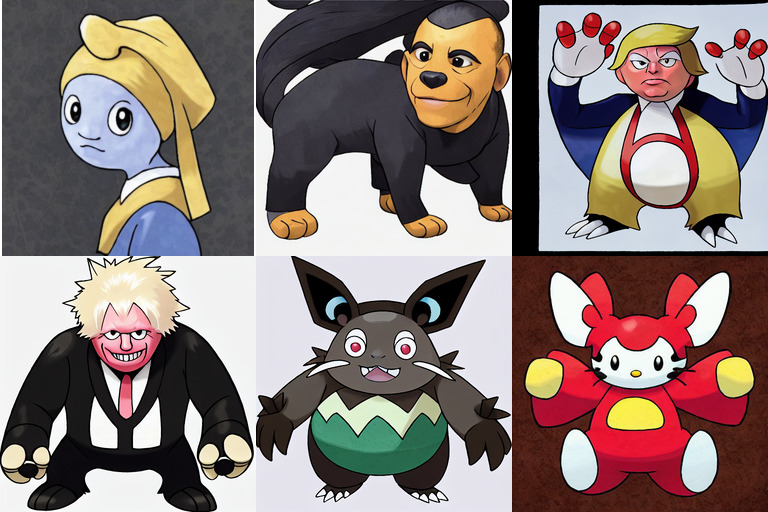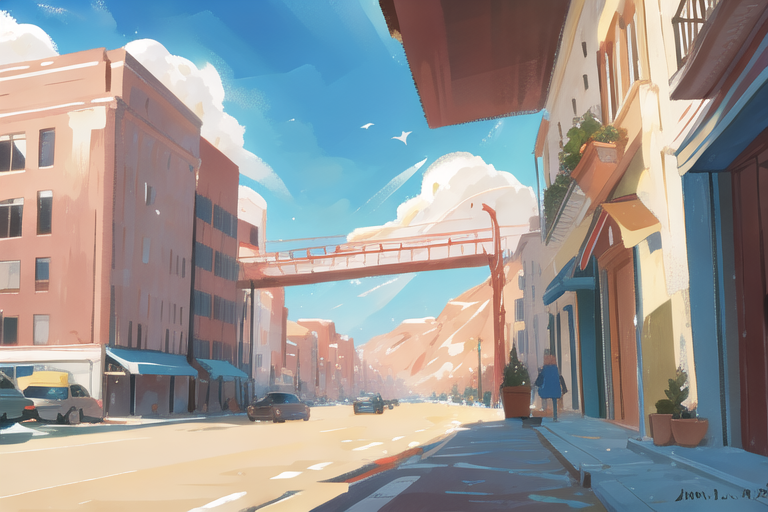text-to-pokemon
Maintainer: lambdal

7.8K

| Property | Value |
|---|---|
| Model Link | View on Replicate |
| API Spec | View on Replicate |
| Github Link | View on Github |
| Paper Link | No paper link provided |
Create account to get full access
Model overview
The text-to-pokemon model, created by Lambda Labs, is a Stable Diffusion-based AI model that can generate Pokémon characters from text prompts. This model builds upon the capabilities of the Stable Diffusion model, which is a latent text-to-image diffusion model capable of generating photo-realistic images from any text input.
The text-to-pokemon model has been fine-tuned on a dataset of BLIP captioned Pokémon images, allowing it to generate unique Pokémon creatures based on text prompts. This is similar to other Stable Diffusion variants, such as the sd-pokemon-diffusers and pokemon-stable-diffusion models, which also focus on generating Pokémon-themed images.
Model inputs and outputs
Inputs
- Prompt: A text description of the Pokémon character you would like to generate.
- Seed: An optional integer value to set the random seed, allowing you to reproduce the same generated image.
- Guidance Scale: A value that controls the influence of the text prompt on the generated image, with higher values leading to outputs that more closely match the prompt.
- Num Inference Steps: The number of denoising steps to perform during the image generation process.
- Num Outputs: The number of Pokémon images to generate based on the provided prompt.
Outputs
- Images: The generated Pokémon images, returned as a list of image URLs.
Capabilities
The text-to-pokemon model can generate a wide variety of unique Pokémon creatures based on text prompts, ranging from descriptions of existing Pokémon species to completely novel creatures. The model is capable of capturing the distinct visual characteristics and features of Pokémon, such as their body shapes, coloration, and distinctive features like wings, tails, or other appendages.
What can I use it for?
The text-to-pokemon model can be used to create custom Pokémon art and content for a variety of applications, such as:
- Generating unique Pokémon characters for use in fan art, stories, or games
- Exploring creative and imaginative Pokémon designs and concepts
- Developing Pokémon-themed assets for use in web content, mobile apps, or other digital media
Things to try
Some interesting prompts to try with the text-to-pokemon model include:
- Describing a Pokémon with a unique type or elemental affinity, such as a "fire and ice type dragon Pokémon"
- Combining different Pokémon features or characteristics, like a "Pokémon that is part cat, part bird, and part robot"
- Generating Pokémon based on real-world animals or mythological creatures, such as a "majestic unicorn Pokémon" or a "Pokémon based on a giant panda"
Experimenting with the guidance scale and number of inference steps can also produce a range of different results, from more realistic to more abstract or stylized Pokémon designs.
This summary was produced with help from an AI and may contain inaccuracies - check out the links to read the original source documents!
Related Models

sdxl-lightning-4step

169.8K
sdxl-lightning-4step is a fast text-to-image model developed by ByteDance that can generate high-quality images in just 4 steps. It is similar to other fast diffusion models like AnimateDiff-Lightning and Instant-ID MultiControlNet, which also aim to speed up the image generation process. Unlike the original Stable Diffusion model, these fast models sacrifice some flexibility and control to achieve faster generation times. Model inputs and outputs The sdxl-lightning-4step model takes in a text prompt and various parameters to control the output image, such as the width, height, number of images, and guidance scale. The model can output up to 4 images at a time, with a recommended image size of 1024x1024 or 1280x1280 pixels. Inputs Prompt**: The text prompt describing the desired image Negative prompt**: A prompt that describes what the model should not generate Width**: The width of the output image Height**: The height of the output image Num outputs**: The number of images to generate (up to 4) Scheduler**: The algorithm used to sample the latent space Guidance scale**: The scale for classifier-free guidance, which controls the trade-off between fidelity to the prompt and sample diversity Num inference steps**: The number of denoising steps, with 4 recommended for best results Seed**: A random seed to control the output image Outputs Image(s)**: One or more images generated based on the input prompt and parameters Capabilities The sdxl-lightning-4step model is capable of generating a wide variety of images based on text prompts, from realistic scenes to imaginative and creative compositions. The model's 4-step generation process allows it to produce high-quality results quickly, making it suitable for applications that require fast image generation. What can I use it for? The sdxl-lightning-4step model could be useful for applications that need to generate images in real-time, such as video game asset generation, interactive storytelling, or augmented reality experiences. Businesses could also use the model to quickly generate product visualization, marketing imagery, or custom artwork based on client prompts. Creatives may find the model helpful for ideation, concept development, or rapid prototyping. Things to try One interesting thing to try with the sdxl-lightning-4step model is to experiment with the guidance scale parameter. By adjusting the guidance scale, you can control the balance between fidelity to the prompt and diversity of the output. Lower guidance scales may result in more unexpected and imaginative images, while higher scales will produce outputs that are closer to the specified prompt.
Updated Invalid Date

airoboros-llama-2-70b

17
airoboros-llama-2-70b is a large language model with 70 billion parameters, created by fine-tuning the base Llama 2 model from Meta on a dataset curated by Jon Durbin. This model is part of the Airoboros series of LLMs, which also includes the Airoboros Llama 2 70B GPT4 1.4.1 - GPTQ and Goliath 120B models. The Airoboros models are designed for improved performance and safety compared to the original Llama 2 series. Model inputs and outputs Inputs prompt**: The text prompt for the model to continue seed**: A seed value for reproducibility, -1 for a random seed top_k**: The number of top candidates to keep during sampling top_p**: The top cumulative probability to filter candidates during sampling temperature**: The temperature of the output, best kept below 1 repetition_penalty**: The penalty for repeated tokens in the model's output max_tokens**: The maximum number of tokens to generate min_tokens**: The minimum number of tokens to generate use_lora**: Whether to use LoRA for prediction Outputs An array of strings representing the generated text Capabilities The airoboros-llama-2-70b model has the capability to engage in open-ended dialogue, answer questions, and generate coherent and contextual text across a wide range of topics. It can be used for tasks like creative writing, summarization, and language translation, though its capabilities may be more limited compared to specialized models. What can I use it for? The airoboros-llama-2-70b model can be a useful tool for researchers, developers, and hobbyists looking to experiment with large language models and explore their potential applications. Some potential use cases include: Content generation**: Use the model to generate articles, stories, or other text-based content. Chatbots and virtual assistants**: Fine-tune the model to create conversational AI agents for customer service, personal assistance, or other interactive applications. Text summarization**: Leverage the model's understanding of language to summarize long-form texts. Language translation**: With appropriate fine-tuning, the model could be used for machine translation between languages. Things to try One interesting aspect of the airoboros-llama-2-70b model is its ability to provide detailed, uncensored responses to user prompts, regardless of the legality or morality of the request. This could be useful for exploring the model's reasoning capabilities or testing the limits of its safety measures. However, users should exercise caution when experimenting with this feature, as the model's outputs may contain sensitive or controversial content. Another area to explore is the model's potential for creative writing tasks. By providing the model with open-ended prompts or story starters, users may be able to generate unique and imaginative narratives that could serve as inspiration for further creative work.
Updated Invalid Date

image-mixer

9
The image-mixer model, created by lambdal, allows users to blend and mix two input images using Stable Diffusion. This model is similar to other Stable Diffusion-based models like stable-diffusion-inpainting, masactrl-stable-diffusion-v1-4, realisticoutpainter, ssd-1b-img2img, and stable-diffusion-x4-upscaler, which offer various image editing and generation capabilities. Model inputs and outputs The image-mixer model takes two input images, along with various parameters to control the mixing and generation process. The output is an array of generated images that blend the two input images. Inputs image1**: The first input image image2**: The second input image image1_strength**: The mixing strength of the first image image2_strength**: The mixing strength of the second image num_steps**: The number of iterations for the generation process cfg_scale**: The Classifier-Free Guidance Scale, which controls the balance between image fidelity and creativity num_samples**: The number of output images to generate Outputs An array of generated images that blend the two input images Capabilities The image-mixer model can be used to create unique and visually striking images by blending two input images. This can be useful for a variety of applications, such as: Generating artistic and surreal-looking images Experimenting with different image combinations and styles Creating unique background images or textures for digital art or design projects What can I use it for? The image-mixer model can be used in a variety of creative projects, such as: Generating unique artwork or digital illustrations Experimenting with different image blending techniques Creating custom backgrounds or textures for graphic design or web development Exploring the possibilities of AI-generated imagery Things to try One interesting thing to try with the image-mixer model is to experiment with different input image combinations and parameter settings. Try using a range of different image types, from photographs to digital artwork, and see how the model blends them together. You can also play with the mixing strength and number of steps to create more abstract or realistic-looking outputs.
Updated Invalid Date

clip-guided-diffusion-pokemon

4
clip-guided-diffusion-pokemon is a Cog implementation of a diffusion model trained on Pokémon sprites, allowing users to generate unique pixel art Pokémon from text prompts. This model builds upon the work of the CLIP-Guided Diffusion model, which uses CLIP to guide the diffusion process for image generation. By focusing the model on Pokémon sprites, the clip-guided-diffusion-pokemon model is able to produce highly detailed and accurate Pokémon-inspired pixel art. Model inputs and outputs The clip-guided-diffusion-pokemon model takes a single input - a text prompt describing the desired Pokémon. The model then generates a set of images that match the prompt, returning the images as a list of file URLs and accompanying text descriptions. Inputs prompt**: A text prompt describing the Pokémon you want to generate, e.g. "a pokemon resembling ♲ #pixelart" Outputs file**: A URL pointing to the generated Pokémon sprite image text**: A text description of the generated Pokémon image Capabilities The clip-guided-diffusion-pokemon model is capable of generating a wide variety of Pokémon-inspired pixel art images from text prompts. The model is able to capture the distinctive visual style of Pokémon sprites, while also incorporating elements specified in the prompt such as unique color palettes or anatomical features. What can I use it for? With the clip-guided-diffusion-pokemon model, you can create custom Pokémon for use in games, fan art, or other creative projects. The model's ability to generate unique Pokémon sprites from text prompts makes it a powerful tool for Pokémon enthusiasts, game developers, and digital artists. You could potentially monetize the model by offering custom Pokémon sprite generation as a service to clients. Things to try One interesting aspect of the clip-guided-diffusion-pokemon model is its ability to generate Pokémon with unique or unconventional designs. Try experimenting with prompts that combine Pokémon features in unexpected ways, or that introduce fantastical or surreal elements. You could also try using the model to generate Pokémon sprites for entirely new regions or evolutionary lines, expanding the Pokémon universe in creative ways.
Updated Invalid Date